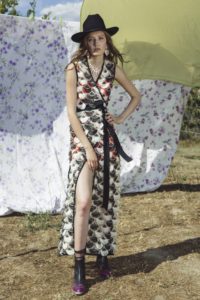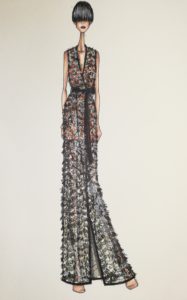A dress is like a story, it tells you about tradition, sometime even about folklore; bewitching like a very ancient legend. It echoes past seasons, taking possession of part of that myth, it may spell bound with its vintage style, typical of symbolic and sophisticated garments, like the Quattromani brand’s creations.
An entirely made-in-Italy label, Quattromani is the result of a symbiotic cooperation and of the foresight of Massimo Noli and Nicola Frau, two extremely creative minds. Work mates and before that friends who met thanks to activity cluster studies, pushed by the same brimming passion: fashion. Fashion felt as the expression of art and design in more complex but also more essential and irrational ways. Accuracy and instinct identify them and turn out in their choice of a clean, minimal chic, absolutely hyper-feminine style code.
Both designers build up on their roots; native Sardinian, they travel over the notes of balladeers and from those singsongs of their childhood, and not only, they invent prints to tell the story of balls in poppy fields; they study iconic leitmotivs like the image of stylized spider as a sort of mandala. It recalls a spider named “Argia” a basic character of the history of Sardinia; according to myths, the only poisonous animal survived from animals Apocalypse, sent by God.

In other instances, the construction can start from a “physical” touch, a sort of emphatic experience with fabrics, tactile vibrations that guide the creative input defining the mood.
A creative epiphany may originate from a dialect song, as well as from a more symbolic item, a touch from their soul, inspired by a film or an exhibition, that unleashes the creative process, like a magic ritual giving birth to shapes and colours.
«Each item is part of the wearer’s life”, they state; however, each single dress is a piece of history, acting as a “gramophone” of a past time that we often hardly recall.
Minimal lines, however with vintage details that bestow garments an evergreen look.
A sophisticated, contemporary feminine touch of selected fabrics wisely fit for visionary women who prefer an everyday refinement. Dynamic women who choose linear, geometrically futuristic accessories, with sophisticated colour combinations.
With its consolidated brand identity, Quattromani grows and conquers market shares they work for: their retail market not only supplies selected multi-brand stores, but also the e-commerce frontier, henceforward a safe channel. Their website hosts an online shop enriched with a blog section to inform and prepare/educate their potential target.
DESCRIPTION OF THE GARMENT
In this issue, we go through a garment from the Spring/Summer 2018 collection by Quattromani. For a detailed study, we relied on the help of Nicola Frau.
Looking at the garment, one notices is the special features of the fabric, a tulle with bangs and sequins. The sleeveless wrap dress features the right front wrapping half of the left front with a waist belt clamping the dress. The armhole, the V-neck, the front and the bottom are trimmed with a contrasting elastic ribbon. The garment is semi-fitted not to alter the fabric pattern; the only seams on the garment are on the sides and on the shoulders. The fabric is partially transparent, as the sew-ons do not cover the cloth entirely; hence, the garment comes with a 105 grams crepe de chine silk petticoat, a simple slip dress with shoulder straps, that covers the body from approximately 8 centimetres over the breast down to mid-thigh.
PRODUCTION STAGES
Cutting is the most critical stage. They cut each garment by hand, the pattern templates being placed barré on the cloth, trying to recompose the fabric pattern on the sides; the bottom and the centre front shall be precisely on line with the warp and weft of the fabric. Then the garment is assembled; due to the sew-ons no hidden stitching is allowed; therefore, sides and shoulders are only overcast. The elastic braid is a perfect solution to trim the edges, provided it is applied stress-free not to alter the outline of the pattern.
The production of the orange slip dress is rather simple, typical of a petticoat, with hidden stitching, a 5+5 mm folded hem, cut in the exact size, and a zip on the side. The petticoat and the belt go to the final pressing, no other operation being planned on the rest of the garment.





